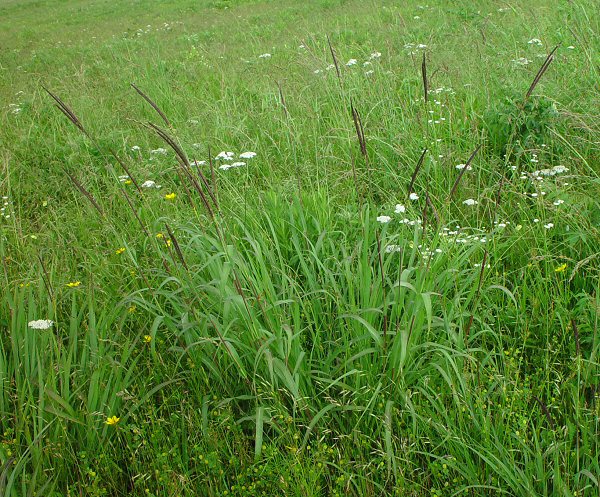Tripsacum dactyloides (L.) L.
Eastern Gama Grass

Native
CC = 5
CW = 0
MOC = 53
© DETenaglia
Tripsacum dactyloides (L.) L.Eastern Gama Grass | |
 |
Native CC = 5 CW = 0 MOC = 53 |
© DETenaglia |
|
Family - Poaceae/Andropogoneae Habit - Perennial, monoecious grass, with short, stout rhizomes, forming clumps. Stems - Ascending to erect, to 2.5 m, mostly unbranched, circular in cross-section or slightly flattened, glabrous. Leaves - Sheaths rounded to keeled on the back, glabrous, the ligule a short membrane with a hairy (fringed) margin. Leaf blades 10-70 cm long, 7-20 mm wide, glabrous or somewhat hairy at the base, flat, the midvein noticeably thickened.
Inflorescence - Inflorescences consisting of 1-4 dense, spikelike racemes, these in a palmate (or nearly so) cluster at the tip of the stem, 10-30 cm long, with staminate spikelets toward the tip and pistillate spikelets in the basal 1/3-1/2, disarticulating at the axis joints, the staminate portion often shed as an intact unit.
Spikelets - Staminate spikelets paired along 1 side of the flattened axis, both sessile or very short-stalked, similar in size and appearance, the glumes 5-10 mm long, longer than the florets, elliptic, usually narrowed to 2 minute teeth at the tip, faintly 9-16-nerved and usually 2-keeled near the margins, firm, glabrous or minutely hairy at the tip. Staminate lemmas 4-9 mm long, elliptic-ovate, thin, awnless. Anthers 3-7 mm long. Pistillate spikelets single, closely appressed to (appearing sunken into) concave portions on 1 side of the axis, with 2 florets, the lowermost usually sterile and reduced, the uppermost fertile. Glumes 5-9 mm long, the outer (lowermost) glume wrapped around and enclosing the rest of the spikelet, broadly ovate in outline, pointed or narrowed to 2 minute teeth at the tip, thick, hardened and bony at maturity, faintly many-nerved, glabrous (the axis joints with small tufts of hair at the spikelet bases), shiny. Pistillate lemmas and paleas, 3-7 mm long, narrowly ovate, membranous, awnless. Fruits enclosed in the persistent glumes and axis joints.
Fruits - Enclosed in the persistent glumes and axis joints, breaking apart into pellet-like segments. Flowering - May - September. Habitat - Upland prairies, glades, savannas, woodland margins, roadsides, railroads, fields, open disturbed areas. Origin - Native to U.S. Lookalikes - None. Other info. - This big species can be found scattered throughout most of Missouri, most abundantly toward the southern and western portions of the state. It also occurs across the southeastern quadrant of the continental U.S. The plant is a characteristic upland prairie species. It is recognized by its tall, stiff and robust flowering stems which bear staminate and pistillate flowers at different locations. The maturing fruits remain enclosed in bony glumes, which break apart into distinctive pellet-like segments. Photographs taken at Taberville Prairie, MO., 6-7-03 and 6-16-05 (DETenaglia); also at Shaw Nature Reserve, Franklin County, MO, 7-2-2011 and 6-27-2013 (SRTurner). |